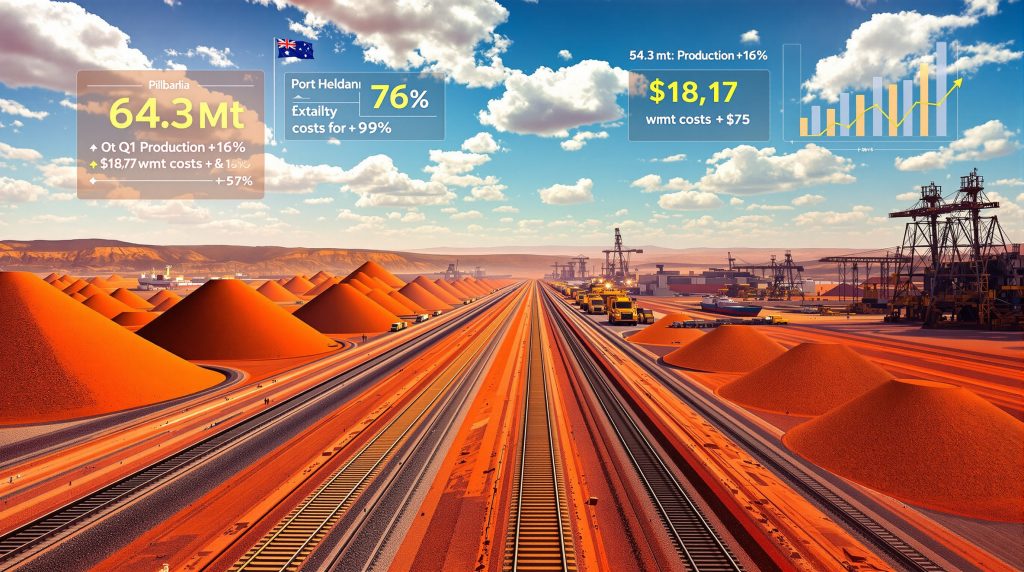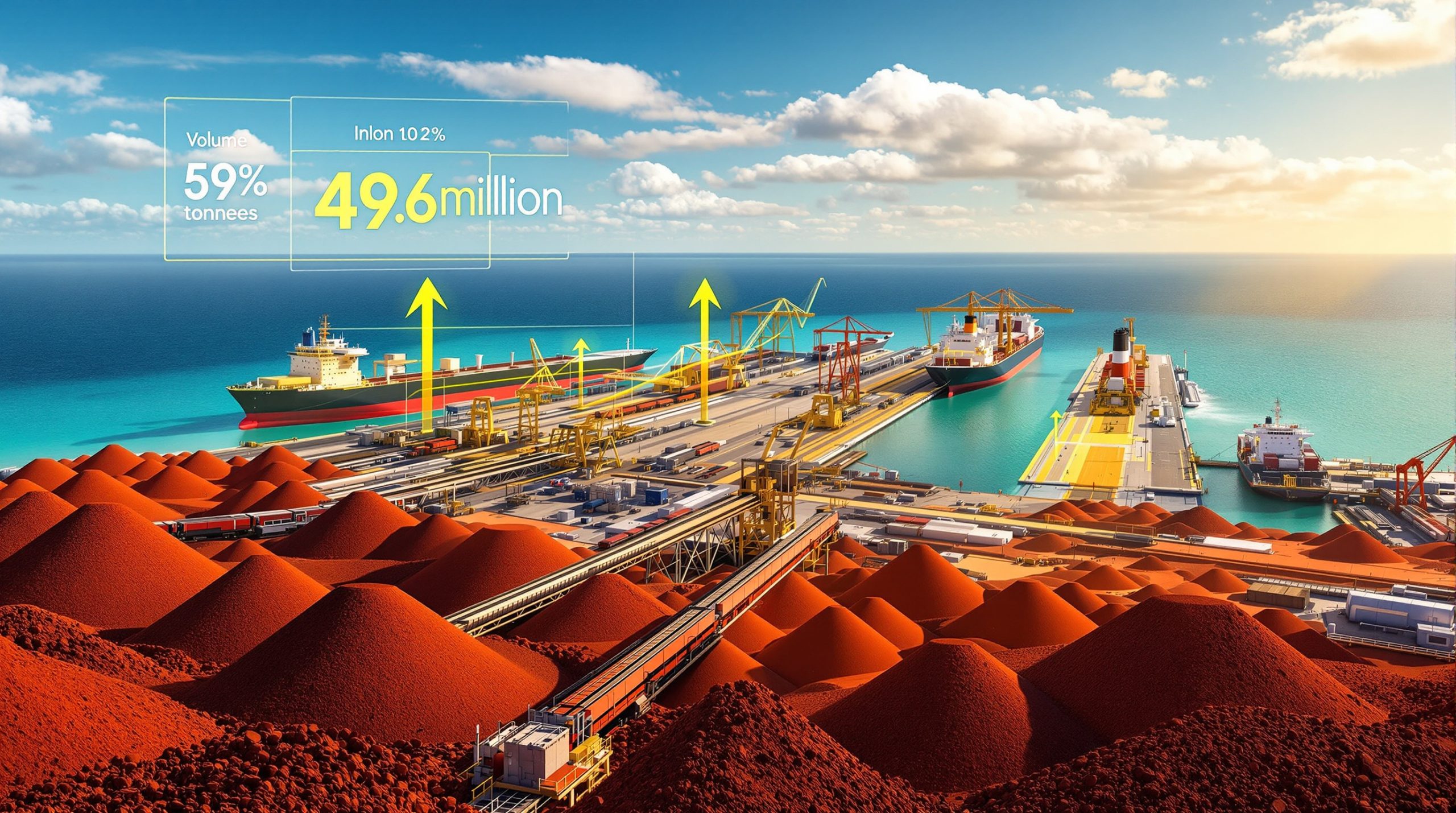Understanding Fortescue's Operational Excellence Framework
Australia's fourth-largest iron ore producer has established itself as a dominant force in the Pilbara region through systematic operational improvements and strategic infrastructure investments. The company's recent quarterly performance demonstrates how Fortescue iron ore shipments increase reflects integrated supply chain management and cost optimization that drive substantial production gains even in challenging market conditions.
Production Volume Breakthrough Analysis
Fortescue's first quarter of fiscal 2025 delivered remarkable production metrics that underscore the company's operational maturity. Quarterly output reached 64.3 million tonnes, representing a substantial 16% increase compared to the previous period, according to Reuters reporting on October 22, 2025. This performance contributed to annual production climbing to 238.9 million tonnes, marking a 10% growth trajectory that positions the company among the world's most efficient iron ore operations.
The hematite operations segment proved particularly robust, delivering 47.6 million tonnes in Q1, which represents a 3.3% year-over-year improvement despite broader market headwinds. Furthermore, this consistent performance across different ore grades demonstrates Fortescue's ability to optimize product mix based on market demand while maintaining operational efficiency across its extensive mining network.
Key production achievements include:
• Record-breaking quarterly output exceeding previous benchmarks
• Sustained annual production growth despite commodity price pressures
• Improved hematite ore processing capabilities
• Enhanced integration between mining and processing operations
Shipment Efficiency Metrics
The translation of production gains into market deliveries showcases Fortescue's logistical capabilities and port infrastructure optimization. Q1 shipments totaled 49.7 million tonnes versus 47.7 million tonnes in the previous year, representing a 4.2% increase that aligned closely with analyst expectations of 49.6 million tonnes. This demonstrates how Fortescue iron ore shipments increase translates operational excellence into market performance.
Full-year shipments achieved 198.4 million tonnes, marking a 4% annual increase that demonstrates consistent operational execution throughout challenging market periods. In addition, the Port Hedland facilities maintained their position as critical export infrastructure, with capacity above 190 million tonnes annually supporting both domestic operations and strategic partnerships with international steel producers.
This shipping performance reflects several operational advantages:
• Integrated rail and port infrastructure reducing bottlenecks
• Automated loading systems improving turnaround times
• Strategic berth allocation optimizing vessel scheduling
• Quality control systems ensuring consistent product specifications
What Cost Management Strategies Drive Fortescue's Competitive Position?
Cost leadership remains fundamental to Fortescue's strategy in an increasingly competitive global iron ore market. The company's ability to reduce unit costs while scaling production demonstrates sophisticated operational management and strategic capital allocation across its integrated supply chain network.
Production Cost Optimization Results
Fortescue achieved significant cost reductions during the first quarter, with production costs decreasing to $18.17 per wet metric ton, representing a 9.9% reduction compared to the same period in the previous year. However, this improvement occurred despite inflationary pressures affecting labor, energy, and consumables across the Australian mining sector.
The integration of low-grade hematite products into the production mix provided additional cost control benefits while maintaining overall product quality standards. For instance, this strategic approach allows the company to maximize resource utilization from existing operations while reducing per-unit processing costs through economies of scale.
| Cost Component | Q1 2025 | Previous Year | Change |
|---|---|---|---|
| Unit Production Cost | $18.17/wmt | $20.16/wmt | -9.9% |
| Total Quarterly Output | 64.3 Mt | 55.5 Mt | +16% |
| Hematite Production | 47.6 Mt | 46.1 Mt | +3.3% |
Operational efficiency improvements across the 760-kilometer railway network contributed significantly to these cost reductions. Moreover, the heavy-haul railway system connects multiple mining operations to port facilities, enabling consolidated transportation that reduces per-tonne logistics costs while improving delivery reliability for international customers.
Financial Leverage and Capital Structure
Strategic financing initiatives support Fortescue's long-term competitive positioning while funding decarbonization investments. The company drew down a 14.2 billion yuan ($1.99 billion) facility at a 3.8% fixed rate, demonstrating access to favorable financing terms from international capital markets.
This five-year syndicated term loan from Chinese and international lenders, including major institutions such as Bank of China and ICBC, provides financial flexibility for both operational requirements and strategic sustainability initiatives. Furthermore, the yuan-denominated structure aligns with Fortescue's significant exposure to Chinese steel markets while providing natural currency hedging benefits.
The financing structure offers several strategic advantages:
• Fixed interest rates providing cost certainty over the loan term
• Multi-currency exposure reducing foreign exchange risks
• Relationship banking with key Asian financial institutions
• Dedicated funding for decarbonization technology investments
How Does Fortescue's Infrastructure Support Massive Scale Operations?
Fortescue's integrated infrastructure network represents one of the most sophisticated mining logistics systems globally, enabling the company to achieve industry-leading productivity metrics while maintaining operational reliability across vast geographic distances in the challenging Pilbara environment.
Railway and Logistics Capabilities
The company's heavy-haul railway spans 760 kilometers through the Pilbara region, connecting multiple mining operations to export terminals at Port Hedland. This privately-owned infrastructure provides complete supply chain control, enabling optimized scheduling, maintenance, and capacity utilization that would be difficult to achieve through third-party logistics providers.
Automated truck operations enhance productivity across mining sites by reducing labor costs, improving safety outcomes, and enabling 24-hour operations in remote locations. In addition, the integration of autonomous haul trucks with conventional mining equipment demonstrates Fortescue's commitment to technological innovation while maintaining operational flexibility.
Port Hedland export terminals handle capacity exceeding 190 million tonnes, positioning the facilities among the world's largest iron ore export hubs. The terminals feature:
• Deep-water berths accommodating large bulk carriers
• Automated loading systems reducing vessel turnaround times
• Storage facilities enabling production smoothing and quality blending
• Rail integration eliminating truck transport to port facilities
Production Facility Integration
The Iron Bridge project contributes 10-12 million tonnes to annual guidance, representing a significant capacity addition that enhances Fortescue's product diversification strategy. This magnetite operation produces higher-grade concentrate suitable for premium steel applications, expanding the company's addressable market beyond traditional hematite customers.
Hematite operations form the core production base, leveraging decades of operational experience and continuous improvement initiatives. These facilities benefit from established infrastructure, proven ore reserves, and optimized processing circuits that deliver consistent product quality at competitive costs.
Processing facilities are optimized for various ore grades, enabling the company to maximize resource recovery from mining operations while producing differentiated products for specific customer applications. However, this flexibility proves particularly valuable during market volatility when demand patterns shift between different steel industry segments.
What Market Challenges Impact Fortescue's Financial Performance?
Despite operational excellence and production growth, Fortescue faces significant headwinds from global commodity markets, particularly weakening demand from China's steel industry and oversupply conditions affecting pricing structures across the iron ore sector.
Revenue Pressures and Market Dynamics Analysis
Annual profit declined 41% despite higher shipment volumes, illustrating the significant impact of commodity price weakness on mining company financial performance. This disconnect between operational success and financial outcomes reflects broader market dynamics affecting all major iron ore producers globally.
Chinese demand patterns show structural changes as the country's economy transitions toward services and away from infrastructure-intensive growth models. Consequently, steel production requirements have moderated compared to previous decades, creating oversupply conditions in global iron ore markets that pressure pricing for all producers regardless of operational efficiency.
Global oversupply conditions pressure margins across the industry, with multiple new projects coming online while demand growth remains constrained. Furthermore, this market environment particularly challenges higher-cost producers while companies like Fortescue with leading cost positions maintain competitive advantages through operational excellence.
Market challenges include:
• Reduced Chinese steel production affecting demand fundamentals
• New supply from competing jurisdictions increasing market competition
• Currency fluctuations impacting pricing and cost structures
• Regulatory changes affecting trade flows and market access
Strategic Response to Market Conditions
Fortescue maintained FY2026 guidance at 195-205 million tonnes, demonstrating confidence in operational capabilities despite market uncertainties. This guidance reflects management's assessment of both production capacity and market demand patterns over the medium term.
Product mix adjustments optimize revenue streams by directing production toward higher-value applications and customer segments. The company's ability to produce both hematite and magnetite products provides flexibility to respond to changing market conditions and customer preferences.
Cost reduction initiatives across operations focus on sustainable efficiency improvements rather than short-term cost cutting that might compromise long-term competitiveness. These programs target areas such as energy consumption, maintenance optimization, and supply chain management while preserving operational integrity and safety standards.
Investment Consideration: Fortescue's operational metrics demonstrate strong execution capabilities, but investors should carefully evaluate commodity price exposure and market demand trends when assessing long-term investment potential in the iron ore sector.
Why Does Fortescue's Scale Matter for Global Iron Ore Markets?
Scale advantages in iron ore mining extend beyond simple cost benefits, encompassing market influence, infrastructure efficiency, and strategic flexibility that smaller competitors cannot easily replicate. Fortescue's position as a major global producer creates significant barriers to entry while providing negotiating power with customers and suppliers.
Global Ranking and Industry Impact
As the fourth-largest iron ore miner worldwide, Fortescue wields considerable influence over global supply patterns and pricing dynamics. The company's production decisions can materially impact market conditions, particularly during periods of tight supply or demand volatility.
Australian Pilbara region dominance provides geological advantages through high-grade ore deposits, established infrastructure, and proximity to Asian steel markets. For instance, the region's iron ore quality and logistics capabilities create natural competitive advantages that are difficult for other jurisdictions to replicate.
Supply chain reliability for Asian steel markets positions Fortescue as a strategic partner for major steel producers requiring consistent, high-quality iron ore deliveries. However, understanding iron ore price trends remains crucial for evaluating long-term relationships with key customers that provide revenue stability while enabling collaborative planning for future capacity requirements.
Competitive advantages include:
• Proven ore reserves supporting decades of production
• Established customer relationships in key Asian markets
• Infrastructure scale enabling low-cost operations
• Technical expertise in Pilbara geology and mining conditions
Production Capacity Utilisation
Near-record shipment levels demonstrate operational maturity across Fortescue's integrated mining and logistics network. The ability to consistently achieve high capacity utilization rates while maintaining cost competitiveness reflects sophisticated operational management and continuous improvement programs.
Consistent quarterly performance improvements show systematic gains from operational optimization rather than one-time factors or favorable market conditions. This consistency provides confidence in the sustainability of performance improvements and management's ability to adapt to changing conditions.
Infrastructure investments supporting future growth ensure Fortescue maintains competitive positioning as global demand patterns evolve. Furthermore, these investments target both operational efficiency and product quality improvements that enhance long-term market competitiveness.
How Will Fortescue's Future Outlook Shape Industry Trends?
Fortescue's strategic direction and operational capabilities will significantly influence global iron ore market development, particularly regarding sustainable mining practices, product innovation, and supply chain optimization across the industry.
Forward-Looking Production Targets
FY2026 shipment targets maintained between 195-205 million tonnes reflect management's confidence in both operational capabilities and market demand assessment. This guidance incorporates various scenarios for global steel demand while accounting for operational flexibility across Fortescue's production network.
Iron Bridge project expansion contributions will enhance product diversification by adding premium magnetite concentrate to Fortescue's product portfolio. This higher-grade material commands premium pricing while serving specialised steel applications that require superior iron content and reduced impurities.
Decarbonisation investments balance with production goals, demonstrating how major mining companies can pursue sustainability initiatives while maintaining operational excellence. In addition, Fortescue's approach to carbon reduction includes both operational improvements and development of alternative energy sources for mining operations.
Strategic priorities include:
• Maintaining production guidance despite market uncertainties
• Expanding premium product capabilities through Iron Bridge
• Integrating sustainability initiatives with operational excellence
• Developing next-generation mining technologies and processes
Strategic Investment Priorities
Yuan-denominated financing for sustainability initiatives demonstrates innovative approaches to funding long-term strategic projects while managing currency exposure. This financing structure aligns with Fortescue's significant business relationships in Chinese markets while supporting environmental improvement programs.
Operational efficiency technology implementations focus on automation, digitalization, and process optimization to maintain cost leadership while improving safety and environmental performance. These investments target sustainable competitive advantages rather than short-term efficiency gains.
Market positioning for long-term competitiveness requires continuous investment in operational capabilities, product quality, and customer relationships. For instance, understanding broader iron ore demand insights helps guide Fortescue's strategic approach that balances immediate operational performance with long-term market position preservation.
What Investment Implications Emerge from Fortescue's Performance?
Fortescue's operational excellence and financial performance present both opportunities and risks for investors evaluating exposure to iron ore markets and Australian mining companies. Understanding these implications requires careful analysis of both company-specific factors and broader industry dynamics.
Shareholder Value Considerations
Production growth versus profitability balance illustrates the complex relationship between operational success and financial returns in commodity-dependent businesses. While Fortescue demonstrates superior operational execution, profitability remains subject to external market forces beyond management control.
Volume increases offset by commodity price pressures show how even operationally excellent companies cannot fully insulate shareholders from commodity cycle volatility. This dynamic requires investors to consider both operational metrics and market timing when evaluating investment positions.
Cost management effectiveness demonstration provides confidence in management's ability to maintain competitive positioning through various market conditions. Furthermore, Fortescue's cost reduction achievements during challenging periods suggest sustainable operational advantages.
Investment considerations include:
• Operational excellence providing downside protection during weak markets
• Scale advantages creating barriers to entry for potential competitors
• Infrastructure assets retaining value across commodity cycles
• Management track record of adaptation to changing market conditions
Market Positioning Strength
Consistent operational delivery track record demonstrates management competence and organisational capabilities that extend beyond favourable market conditions. This operational reliability provides foundation for long-term shareholder value creation.
Scale advantages in challenging market conditions become particularly valuable during industry downturns when smaller competitors face financial stress. Moreover, Fortescue's cost position and financial resources provide flexibility to maintain operations and potentially gain market share.
Strategic financial flexibility through diversified funding enables the company to pursue growth opportunities and navigate market volatility without compromising operational integrity. However, access to multiple funding sources and currencies reduces financial risk while supporting strategic initiatives.
How Does Fortescue Compare to Industry Trends?
The Fortescue iron ore shipments increase reflects broader industry trends while highlighting the company's unique positioning within global mining operations. Understanding these dynamics provides context for evaluating Fortescue's competitive advantages and future prospects.
Industry Context and Competitive Positioning
Recent developments across the mining sector demonstrate varying operational approaches and market strategies. Notably, other companies have experienced different outcomes with their resumed iron haulage operations, highlighting how operational excellence varies significantly across industry participants.
Mining companies increasingly focus on capital raising methods to fund expansion projects and sustainability initiatives. Fortescue's innovative yuan-denominated financing demonstrates sophisticated approaches to securing capital while managing currency exposure and maintaining strategic flexibility.
The broader mining industry evolution encompasses technological advancement, environmental sustainability, and operational efficiency improvements. Fortescue's performance exemplifies how leading companies adapt to these trends while maintaining competitive positioning.
Future Market Dynamics
According to AFR reporting on October 20, 2025, Fortescue's iron ore record helps offset challenges in green energy divisions, demonstrating how operational excellence in core business segments provides financial stability for strategic diversification initiatives.
The Fortescue iron ore shipments increase positions the company favourably for future market developments, particularly as global steel demand patterns evolve and environmental regulations become more stringent across major consuming regions.
Investment implications extend beyond immediate financial performance to encompass long-term strategic positioning, operational resilience, and management capability to navigate complex market conditions while maintaining competitive advantages through sustained operational excellence.
Disclaimer: This analysis is for informational purposes only and should not be considered investment advice. Iron ore markets are subject to significant volatility, and mining company investments carry inherent risks including commodity price fluctuations, operational challenges, and regulatory changes. Investors should conduct their own research and consult qualified financial advisors before making investment decisions.
Ready to Capitalise on Mining Production Breakthroughs?
Discovery Alert's proprietary Discovery IQ model delivers real-time alerts on significant ASX mineral discoveries, helping investors identify actionable opportunities like production growth stories before the broader market responds. Explore Discovery Alert's dedicated discoveries page to understand why major mineral breakthroughs can generate substantial returns, then begin your 30-day free trial to position yourself ahead of the market.




